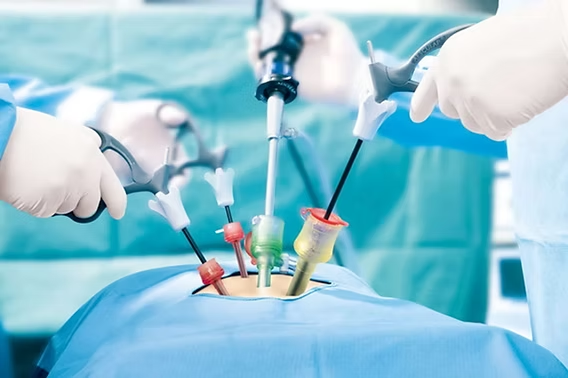- Emergency Line:(+91) 9555943636
- Mon - Fri: 9:00 am - 5:00 pm (24x7 Emergency)
- 8 Marla, Model Town, Sonipat, Haryana 131001
General Surgery Excellence at Primax Gastro Institute & Superspeciality Hospital, Sonipat


At Primax Gastro Institute & Superspeciality Hospital, our General Surgery Department offers a broad range of surgical care with a focus on safety, precision, and faster recovery. Backed by modern operation theatres and advanced surgical tools, our team of experienced surgeons performs both routine and emergency procedures with the highest standards of care.
We specialize in laparoscopic (keyhole) and open surgeries for conditions like hernias, gallstones, appendicitis, piles, fissures, thyroid disorders, and soft tissue tumors. Our surgical approach emphasizes minimal invasiveness, reduced hospital stay, and optimal healing.
Whether it’s a planned procedure or a life-saving emergency intervention, the Primax surgical team ensures that each patient receives comprehensive, personalized, and compassionate surgical care.



Gastrointestinal conditions require specialized surgical expertise that combines precision with comprehensive care. Our GI surgery specialists at Primax Hospital provide world-class treatment for complex digestive tract disorders.
Understanding Gastrointestinal Surgical Conditions: Gastrointestinal surgeries encompass procedures involving the entire digestive tract, from esophagus to rectum. These surgeries address both benign and malignant conditions affecting your digestive health and overall quality of life.
Immediate Attention Required If You Experience:
| Symptom Category | Description | Action Required |
|---|---|---|
| Early Signs | Persistent abdominal discomfort, changes in bowel habits | Schedule consultation |
| Progressive Symptoms | Chronic pain, unexplained weight loss, fatigue | Urgent evaluation needed |
| Acute Complications | Severe pain + fever + vomiting | Emergency visit required |
| Critical Signs | Peritonitis signs + shock + severe distension | IMMEDIATE EMERGENCY |
🔬 Precise Diagnosis:
⚕️ Minimally Invasive Surgical Options:
🏥 Comprehensive Post-Surgical Care:
Our surgical team specializes in advanced minimally invasive techniques and provides personalized care throughout your treatment journey.
With state-of-the-art technology, expert surgeons, and a dedicated support staff, we ensure safe, effective, and compassionate care for every patient undergoing laparoscopic small bowel surgery.
Hernias affect millions of people worldwide, but with our specialized hernia surgery expertise, you can achieve permanent relief with minimal downtime and excellent cosmetic results.
Understanding Hernia Conditions: A hernia occurs when an internal organ pushes through a weak spot in your muscle or tissue wall. While some hernias cause minimal discomfort, others can lead to serious complications requiring immediate surgical intervention.
| Hernia Type | Key Symptoms | Surgical Urgency |
|---|---|---|
| Inguinal | Groin bulge, lifting discomfort | Elective planning |
| Umbilical | Naval protrusion, tender area | Schedule consultation |
| Incisional | Bulge at surgical site, pain | Early intervention |
| Strangulated | Severe pain + nausea + fever | EMERGENCY SURGERY |
Immediate Emergency Signs:
🔧 Minimally Invasive Approaches:
🧵 Advanced Mesh Technologies:
⚡ Benefits of Our Hernia Surgery:
The hepatobiliary and pancreatic system requires the most sophisticated surgical expertise. Our specialized team handles complex liver, gallbladder, bile duct, and pancreatic surgeries with exceptional precision and outcomes.
Understanding HPB Surgical Conditions: Hepatobiliary and pancreatic surgeries involve some of the most complex procedures in general surgery, requiring extensive expertise and state-of-the-art facilities for optimal patient outcomes.
| Condition Category | Primary Symptoms | Diagnostic Priority |
|---|---|---|
| Gallbladder Disease | Right upper quadrant pain after meals | Routine evaluation |
| Liver Pathology | Jaundice + abdominal swelling + fatigue | Urgent assessment |
| Pancreatic Issues | Severe back/abdominal pain + weight loss | Immediate evaluation |
| Bile Duct Problems | Progressive jaundice + dark urine + pale stools | EMERGENCY WORKUP |
Immediate attention indicators:
🏥 Complex Surgical Procedures:
🔬 Advanced Diagnostic Integration:
✨ Specialized Care Features:
Why Choose Our Hospital?
Our hospital is renowned for its expertise in laparoscopic liver surgery, providing high-quality care with advanced diagnostic tools and modern surgical techniques.
Our skilled surgical team ensures precise, safe removal of liver cysts with a focus on minimal disruption to surrounding tissues.
We provide the best possible treatment outcomes with personalized care, shorter recovery times, and a commitment to patient well-being. Choose us for expert care and a smooth recovery experience.
Our breast and endocrine surgery division provides comprehensive surgical care for breast conditions and endocrine disorders, combining surgical excellence with compassionate patient-centered care.
Understanding Breast and Endocrine Surgical Needs: Breast and endocrine surgeries require specialized expertise in handling delicate hormonal balance and breast tissue, with emphasis on both functional outcomes and cosmetic considerations.
Conditions We Expertly Treat:
Symptom Recognition and Action Guide:
| Condition Type | Warning Signs | Recommended Action |
|---|---|---|
| Breast Changes | New lump, skin changes, nipple discharge | Within 2 weeks consultation |
| Thyroid Issues | Neck swelling, voice changes, difficulty swallowing | Prompt evaluation |
| Hormonal Symptoms | Unexplained weight changes, energy fluctuations | Comprehensive assessment |
| Emergency Signs | Rapid growth, severe pain, systemic symptoms | IMMEDIATE EVALUATION |
When to Seek Our Breast & Endocrine Surgery Expertise:
Prompt Consultation Needed For:
Our Advanced Surgical Approaches:
🎯 Minimally Invasive Techniques:
🔬 Precision Surgical Options:
💝 Comprehensive Care Features:

Booking your consultation is simple and convenient:
Our General Surgery Department at Primax Hospital offers comprehensive surgical services including:
Your recovery experience at Primax Hospital includes:
Primax Hospital provides comprehensive 24/7 emergency general surgery services:
Our focus on minimally invasive surgery means our surgeons use advanced 3D laparoscopic technology. This provides better vision and precision, leading to safer surgeries, shorter hospital stays (often just 1-2 days), and a much faster recovery compared to traditional open surgery.

Thank You for Submitting
You appointment query has been registered you will soon recieve confirmation call from Hospital if not received call@9666460009
